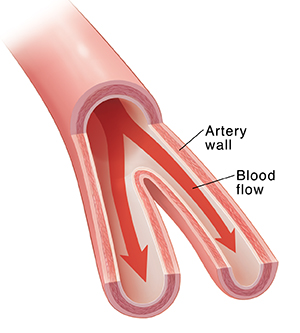Understanding Your Cholesterol Numbers
Understanding Your Cholesterol Numbers
The higher your blood cholesterol, the greater your risk for heart attack (acute myocardial infarction), cardiovascular disease, or stroke. High cholesterol can cause any artery in your body to become narrow. That’s why you need to know your cholesterol level. If it’s high, you can take steps to bring it down. Eating the right foods and getting enough exercise can help. Some people also need medicine to control their cholesterol. Your healthcare provider can help you get started on a plan to control your cholesterol.
Checking your cholesterol
Your cholesterol is checked with a simple blood test. The results tell you how much cholesterol you have in your blood. Get checked as often as your healthcare provider suggests. If you have diabetes or high cholesterol, you may need your blood tested as often as every 3 months. As you work to lower your cholesterol, your numbers will change slowly. But they will change. Be patient and stay on track. Discuss your numbers with your healthcare provider.
Your total cholesterol number
A blood test will give you a number for the total amount of cholesterol in your blood. The higher this number, the more likely it is that cholesterol will build up in your blood vessels. Even if your cholesterol is just slightly high, you are at increased risk for health problems.
My total cholesterol is: ________________
Your lipid numbers
Total cholesterol is just one part of the story. Cholesterol is made up of different kinds of fats (lipids). If your total cholesterol is high, knowing your lipid profile is important. The 2 most important lipids are HDL and LDL. Lipids are checked after you have fasted. This means you don’t eat for a certain amount of time before the test is done. Along with cholesterol, triglyceride can also lead to blocked arteries. Triglycerides are another type of fat. Knowing your HDL, LDL, and triglyceride numbers, as well as your total cholesterol gives you a more complete picture of your cholesterol level:
HDL is called the “good” cholesterol. It moves out of the bloodstream and does not block your blood vessels. HDL levels are affected by how much you exercise and what you eat.
My HDL cholesterol is: ________________
LDL is called the “bad” cholesterol. This is because it can stick to your artery walls and block blood flow. LDL levels are most affected by what you eat and by your genes.
My LDL cholesterol is: ________________
Triglyceride is a type of fat the body uses to store energy. Too much triglyceride can increase your risk for heart disease. Triglyceride levels should be under 150.
My triglyceride is: ________________
Based on your other health issues and risk factors, your healthcare provider may have specific goals for treating your cholesterol. You may need to use different kinds of medicines that work on the different types of cholesterol. Work with your provider to know what your goals of treatment are. Stick with your treatment plan to reach the goals you set.
High-risk groups
Some people may need to take medicines called statins to control their cholesterol. This is in addition to eating a healthy diet and getting regular exercise.
Statins can help you stay healthy. They can also help prevent a heart attack or stroke. You may need to take a statin if you are in one of these groups:
Adults who have had a heart attack or stroke. Or adults who have had peripheral vascular disease, a ministroke (transient ischemic attack), or stable or unstable angina. This group also includes people who have had a procedure to restore blood flow through a blocked artery. These procedures include percutaneous coronary intervention, angioplasty, stent, and open-heart bypass surgery.
Adults who have diabetes. Or adults who are at higher risk of having a heart attack or stroke and have an LDL cholesterol level of 70 to 189 mg/dL
Adults who are 21 years old or older and have an LDL cholesterol level of 190 mg/dL or higher.
If you are in a high-risk group, talk with your healthcare provider about your treatment goals. Make sure you understand why these goals are important, based on your own health history and your family history of heart disease or high cholesterol.
Make a plan to have regular cholesterol checks. You may need to fast before getting this test. Also ask your provider about any side effects your medicines may cause. Let your provider know about any side effects you have. You may need to take more than one medicine to reach the cholesterol goals that you and your provider decide on.
Updated:
October 09, 2017
Sources:
2013 ACC/AHA Guideline on the Treatment of Blood Cholesterol to Reduce Atherosclerotic Cardiovascular Risk in Adults. Stone, N. Circulation. 2013, s1-84.
Reviewed By:
Gandelman, Glenn, MD, MPH,Snyder, Mandy, APRN

